The
Profitable Miracle Mitress Of
|
|
|
| |
because
it faded with long exposure to the sun. From another mine in Ouro
Preto, they were also heating the natural browner imperial topaz
to a refined bubble-gum pink, which was acceptable because the pink
color was stable and greatly improved the unfavorable brownish tone.
It would be very interesting to know how many billion dollars of
blue topaz have been sold since the irradiation of white topaz was
discovered in the 1970's. It may be just the tip of the iceberg
for the profits this topaz mistress will make for you, considering
the high-tech advancements since the dawn of this millennium, such
as Diffused Topaz and Mystic topaz.
Brazilians and Americans used transparent white topaz to irradiate
with cobalt, thereby miraculously transforming it to light blue
topaz. It quickly became a staple in jewelry manufacturing and merchadising,
selling multi -millions of carats per year.
Next, someone from California found that irradiating the same white
topaz with a linear accelerator, instead of cobalt, produced extraordinarily
dazzling shades of sky-blue.
NOTE: The irradiation of white topaz, unlike the straw-color turning
to golden, was more than accepted. It was welcome! Because the changed
color was 100% stable and satisfied a fashion requirement for blue
gemstones, such as aquamarine, at a very affordable price.
Then the British, and soon Americans, were using nuclear reactors
for neutron irradiation to produce dark  sapphire-blue,
christened London-Blue Topaz. the legitimacy for this process was
a grey area, as the government became involved vis-a-vis health
concerns of the citizenry. When it was shown that safe and sound
release-criteria could be satisfactorily demonstrated and proved,
fashion trends triumphed because the saturated blue hue fulfilled
the female craving for sapphire at a mere fraction of the price. sapphire-blue,
christened London-Blue Topaz. the legitimacy for this process was
a grey area, as the government became involved vis-a-vis health
concerns of the citizenry. When it was shown that safe and sound
release-criteria could be satisfactorily demonstrated and proved,
fashion trends triumphed because the saturated blue hue fulfilled
the female craving for sapphire at a mere fraction of the price.
On the heels of the government, lawyers soon became involved with
topaz's miraculous mistress when some more Californians discovered
the combination of linear accelerator and neutron irradiation created
the extraordinarily scintillating and dazzling color that was baptized
Swiss Blue. It was patentable! Was it the beginning of the beginning,
or the beginning of the end for Topaz?
As you will see, it was a new beginning for topaz's established
seductive mistress, technology. She went High-Tech! In fact, topaz's
new color-enhancement, modus operand i is going so High-Tech that
it ALL requires being patened immediately upon its discovery and
development. This, so these small mirables do not take the price-collapse
path of CZ.
It is debatable who was first to discover this new irradiation blend,
but it was certainly a Californian. one group, Natural Arts called
it "New Blue", but never talked to a lawyer about it.
The other group, Mineral Sciences, didn't give it a special name,
but patented the precess and forbade other dealers from duplicating
it. New Blue was soon marketed through Golay Buchel, who trademarked
the name, Swiss Blue Topaz . At that time, Swiss Blue was selling
wholesale for $ 5.00/ct. Within 3 years, regardless of Mineral Sciences'
patent, other dealers were learing the secret and producing the
same color overseas without legal penalty. Before long, Swiss Blue
was wholesaling for less than $ 2.00/ct. |
|
|
|
|
|
|
|
The
exotic colors of Mystic Topaz |
|
|
| |
|
USA Patented
Vapor Deposition Process on Natural Topaz |
|
Capture
the stunning brilliance of Celestial Topaz |
|
|
Experaince
the dazzling and mystifying kaleidoscope of colors! |
|
|
Major
processors and distributors of surface enchanced designer gemstones
by Azotic ™ |
|
|
|
| |
Doesn't
seem like a good product whose price structure could crumble so
easily, right? Wrong! The mistress was making new rules because
of her shift from mere technology to High-Tech: the problem was
the patent holder was not strict enough pursuing patent violators.
In light of supply and demand. The best "bread & butter"
wholesale creations in the jewelry market generally responded the
same, like Amethyst, Citrine and Cubic Zirconium. For easily reproducible
fashion-gems, the more the market demands the more the suppliers
make. The higher the quantities the lower the price, but the overall
profit is well compensated with volume.
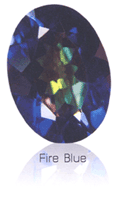 After
25+ years deeply immersed in the blue topaz color enhancement business
I was After
25+ years deeply immersed in the blue topaz color enhancement business
I was 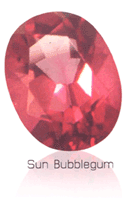 already fascinated and flabbergasted with its attractiveness, adaptabillity
and market attraction. already fascinated and flabbergasted with its attractiveness, adaptabillity
and market attraction.
Enter Mystic Topaz at the turn of this century and millennium. Other
than its mysteriously shimmering sparkling beauty in so many colors,
the real mystery of this phenomenon is why it took so long to catch
on in the gemstone and jewelry industry. The first time I heard
of it was in September 1998 at the Hong Kong Jewelry show, and there
was only that fascinating peacock-green rainbow color. But it didn't
seem to be selling so well then, and it sort of faded out of sight
in the international jewelry business.
.........Until the 2003 Tucson show! In fact, it had been gaining
momentum the previous year, but at Tucson it caught everyone by
surprise. The strongest Mystic booth, M.P.Gem at the AGTA Convention
Center, looked like there was a kaleidoscope of colors and people
were going absolutely berserk for it.
The flaming colors resemble Alexandrite, Ceylon Sapphire, Thai Sapphire,
Burmese Ruby, Thai Ruby, Pink Sapphire, Padparascha Sapphire, Canary
Diamond and many other exotic colors. So the product stood out astonishingly.
Kenneth Moghadam, President of M.P. Gem, sold out his entire stock
by the last day of the show.
Many knowledgeable gem dealers and jewelry marketers say the Mystic
Topaz consumption will soon bypass that of Blue Topaz, the bread-and-butter
darling of the last century's end. So, it appears that this beautiful
mystical space-age gemstone has finally achieved its long overdue
popularity. And it's certainly not limited to size of the blue topaz
market. Mystic Topaz comprises such a large variety of scientillating
celestial, oceanic and earthly hues that each of these living colors
multiplies the popularity, salability and profitability of this
gemstone.  |
|
|
|
|
|
|
|
|
Mid-2004
update:
Success can sometimes be a two-edged sword. As of June, 2004 the
situation in Azotic has become chaotic. They are demanding payment
in advance from all distributors, and there is a backlog of more
than one million carats. It now takes three to four months to receive
stones back from Azotic. So folks, until/if Azotic fires up another
Mystic production facility, do not count on fast deliveries, whatever
the quantities, colors, sizes and shapes.
Mystic Topaz Technical Considerations:
Technically known as Physical Vapor Deposition (PVD) applied to
NATURAL TOPAZ, the deposition coating is on the pavillion, therefore,
the table and crown (face) of the stone is natural topaz and extremely
resistant to scratching, which will last as long any natural gemstone.
For jewelry manufacture, it is best to mount Mystic Topaz with the
same care precautions as one would use mounting emeralds and/or
pearls.
NOTE: The Mystic Topaz process is covered by a
U.S. patent with Azotic Technology, who pursues any potential violators.
And now for the definitive miracle of topaz's charming mistress
= diffused topaz. At the end of the second millennium, "diffused"
coupled with a gem's name was a dirty word in the gemstone and jewelry
trade.
Notorious scams were disclosed whereby customers bought top gem
color blue sapphires and later realized, after a stone was chipped
and/or re-polished, the body color of the "gem" was white
or sky-blue sapphires that had been surface-diffused to achieve
the "gem" color. The American Gem Trade Association (AGTA)
issued Trade Alerts advising that the selling of diffused sapphires
without full discolosure was unethical and violated AGTA's regulations. |
|
|
|
|
|
|
|
Now,
resulting from the beryllium treated orange sapphire revelations
from the Thai corundum burners over the last few years, our gemstone
trade technical knowledge has been updated significantly. Now we
know that diffusion does not deserve such a negative reputation.
Rather, diffusion is an integral part of any gemstone's color enhancement
for corundum (blue and fancy sapphire, and ruby). Even "surface"
diffusion was technically "lattice diffusion", but it
only penetrated a few millimeters instead of throughout the stone,
like the "kosher" blue sapphires.
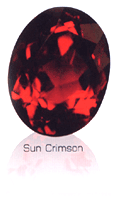 Consequently,
I was not pessimistically shocked to learn about diffused topaz,
except for Consequently,
I was not pessimistically shocked to learn about diffused topaz,
except for the fact that it involved "topaz". The only gemstone diffusion
I had ever known was corundum, requiring temperatures in excess
of 1,600 Centigrade. Many years ago top crystallography experts
agreed that topaz could not possibly be color-enhanced with diffusion
because of the heat required. Such a temperature would turn topaz
to ash! So, I thought someone was mistaking "diffused"
topaz with "Mystic" topaz. the fact that it involved "topaz". The only gemstone diffusion
I had ever known was corundum, requiring temperatures in excess
of 1,600 Centigrade. Many years ago top crystallography experts
agreed that topaz could not possibly be color-enhanced with diffusion
because of the heat required. Such a temperature would turn topaz
to ash! So, I thought someone was mistaking "diffused"
topaz with "Mystic" topaz.
.................Until I talked to Doug Jeffery of Leslie &
Co. (http://www.leslieandco.com), the marketing group exclusively
distributing diffused topaz for the patent owner, my old longtime
friend and old blue-topaz cohort, Richard said he still thought
it could be done so, as Nike says, he just did it! And then he patented
it as PhDProcess® (Pollak heat Diffusion).
As mentioned earlier, Mystic Topaz is a coating which does not penetrate
the stone's surface, so its mounting in jewelry requires the same
precautions to preserve the coating as one would use mounting emeralds
and/or pearls.
Whereas the diffusion of topaz penetartes the surface in millimeters,
so is stable in most acids, bases, steam, ultrasonic cleaners, plating
solutions and heat applications (like a jeweler's torch). Some like
to say the diffusion enhancement is more stable than irradiation.
So now topaz's miracle mistress was showing her phenomenal siren
qualities. It appeared she was defying the laws of nature: capable
of transforming topazin to a myriad of marketable colors through
previously unapproachable means. And, although not as many colors
could be produced with diffusion, it was more stable than Mystic
Topaz's vapor deposition. |
|
|
|
But
the variety of colors for diffussed topaz is certainly no slouch! The PhD
Process® started with EverGreen® Topaz (medium to medium-dark bluish
green), which took the gemstone and jewelry industry by storm at the close
of the millennium. In terms of complexity and stablility, it was a night-and-day
difference from the "dye-fushion" method for standard green quartz.
Since then Richard, his PhD Process® and Leslie & Co. have expanded
their color range of diffused topaz to include:
- Teal Topaz: Medium Greenish Blue (70/30)
- Glacier Blue® Topaz: Medium to Medium Dark blue
- Imperial Champagne® Topaz: Champagne Yellow
- Royal Red® Topaz: Pink to Red
- Bi-color Topaz: Still in development
Today, Diffused and Mystic Topaz have found their way to some T.V. networks,
and a few well known American designers are already supplying some higher
class department stores in the United States.
In the end, the selection between the types of color enhancement you prefer,
the important points are stability and color variety appealing to the customer's
fashion sense.
If high fashion is your aim, and the basic hues of green, blue, red and
yellow are not enough, then you should take a look at Mystic's website:
http://www.azotic.us where you'll find more than 80 different colors.
Contact the author, Tom Banker, at Milagre Enterprises in Bangkok, +662-635-7157,
or
email: tombanker@access.inet.co.th |
 |
|




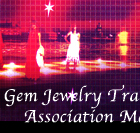

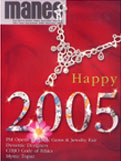



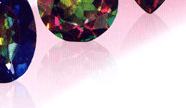

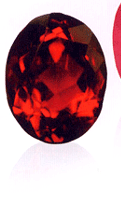
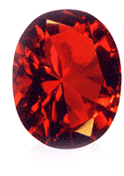

 sapphire-blue,
christened London-Blue Topaz. the legitimacy for this process was
a grey area, as the government became involved vis-a-vis health
concerns of the citizenry. When it was shown that safe and sound
release-criteria could be satisfactorily demonstrated and proved,
fashion trends triumphed because the saturated blue hue fulfilled
the female craving for sapphire at a mere fraction of the price.
sapphire-blue,
christened London-Blue Topaz. the legitimacy for this process was
a grey area, as the government became involved vis-a-vis health
concerns of the citizenry. When it was shown that safe and sound
release-criteria could be satisfactorily demonstrated and proved,
fashion trends triumphed because the saturated blue hue fulfilled
the female craving for sapphire at a mere fraction of the price.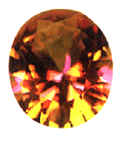
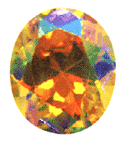

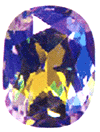
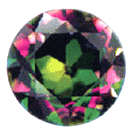


 After
25+ years deeply immersed in the blue topaz color enhancement business
I was
After
25+ years deeply immersed in the blue topaz color enhancement business
I was  already fascinated and flabbergasted with its attractiveness, adaptabillity
and market attraction.
already fascinated and flabbergasted with its attractiveness, adaptabillity
and market attraction.
 Consequently,
I was not pessimistically shocked to learn about diffused topaz,
except for
Consequently,
I was not pessimistically shocked to learn about diffused topaz,
except for the fact that it involved "topaz". The only gemstone diffusion
I had ever known was corundum, requiring temperatures in excess
of 1,600 Centigrade. Many years ago top crystallography experts
agreed that topaz could not possibly be color-enhanced with diffusion
because of the heat required. Such a temperature would turn topaz
to ash! So, I thought someone was mistaking "diffused"
topaz with "Mystic" topaz.
the fact that it involved "topaz". The only gemstone diffusion
I had ever known was corundum, requiring temperatures in excess
of 1,600 Centigrade. Many years ago top crystallography experts
agreed that topaz could not possibly be color-enhanced with diffusion
because of the heat required. Such a temperature would turn topaz
to ash! So, I thought someone was mistaking "diffused"
topaz with "Mystic" topaz.